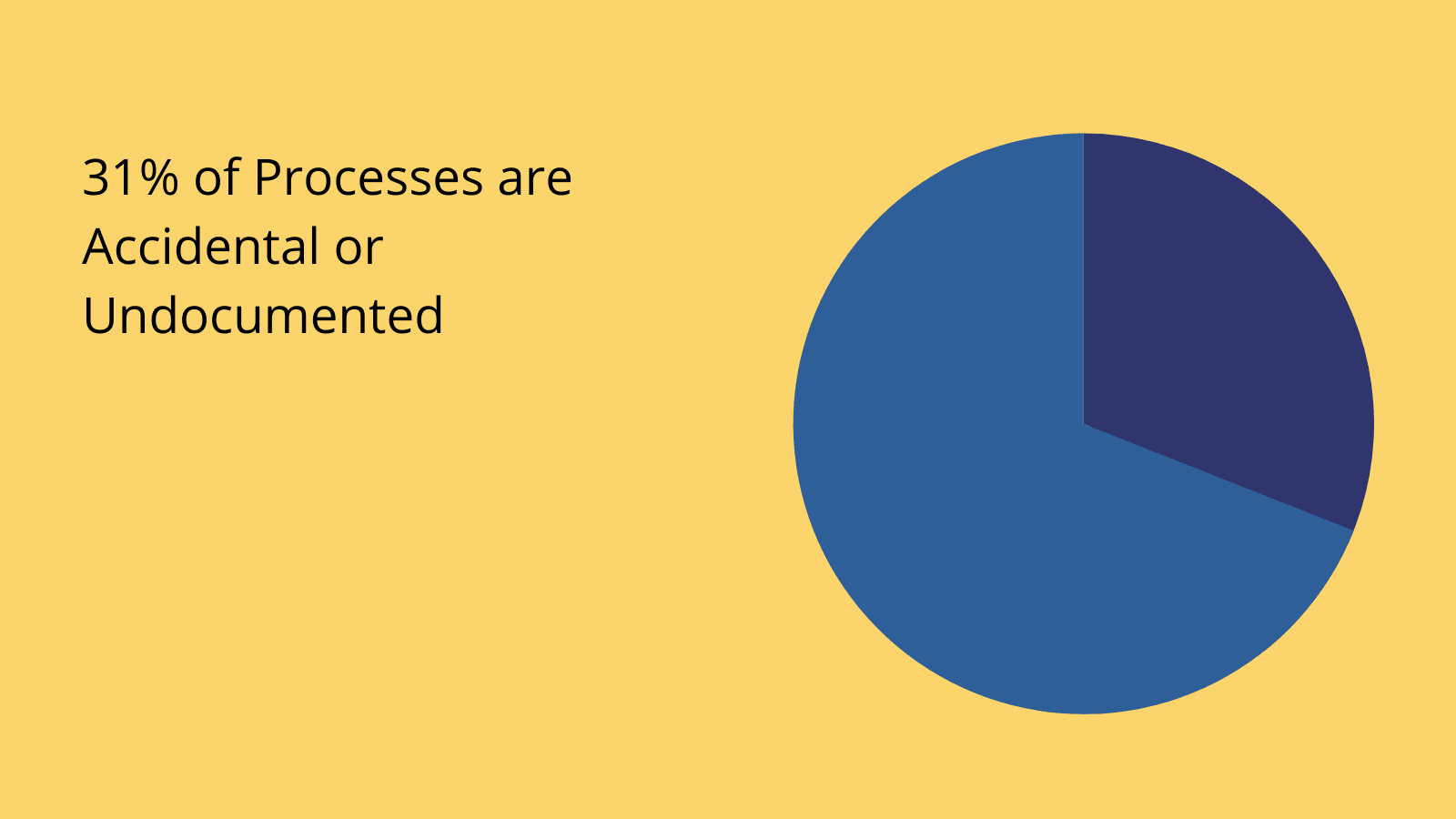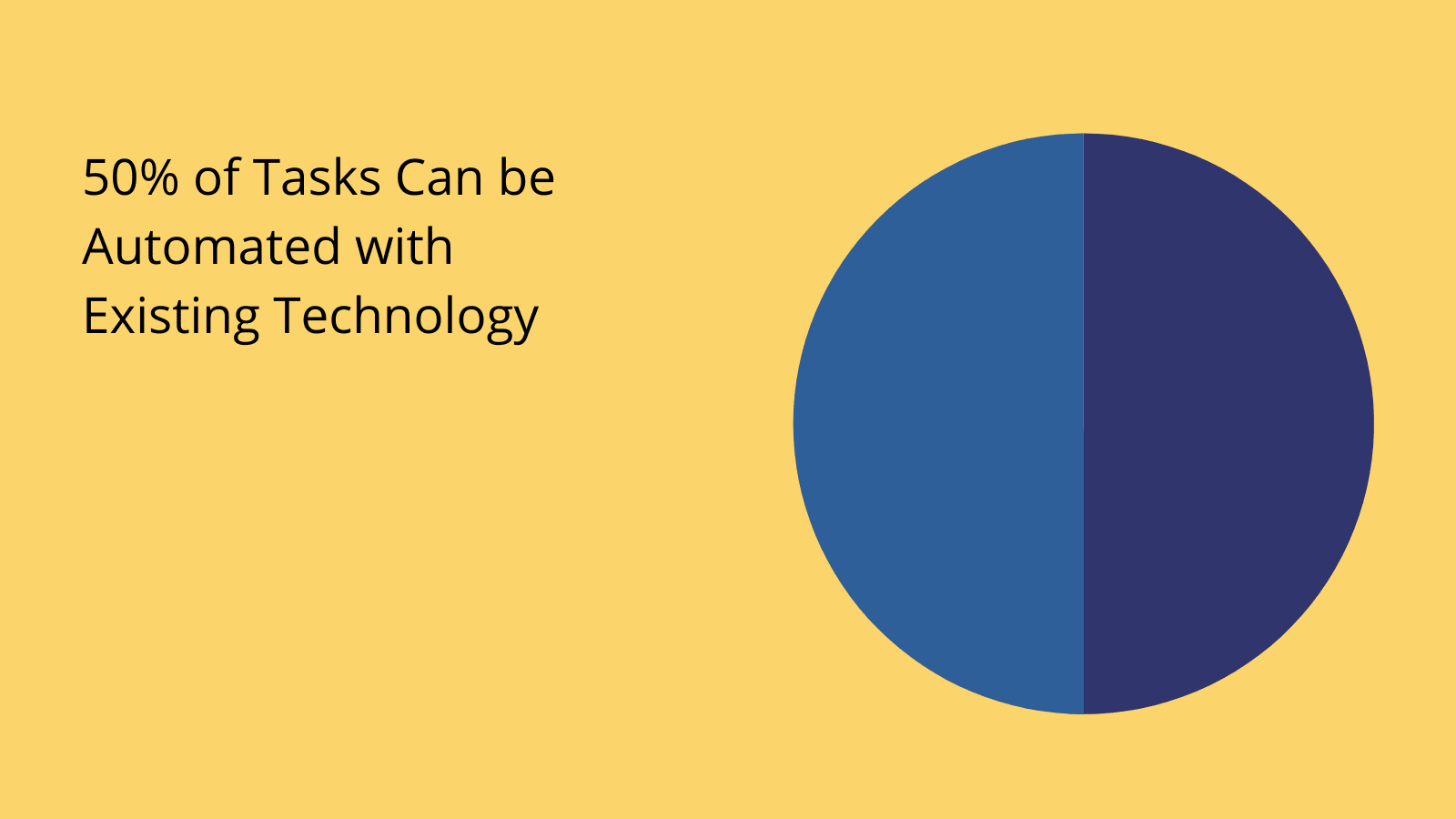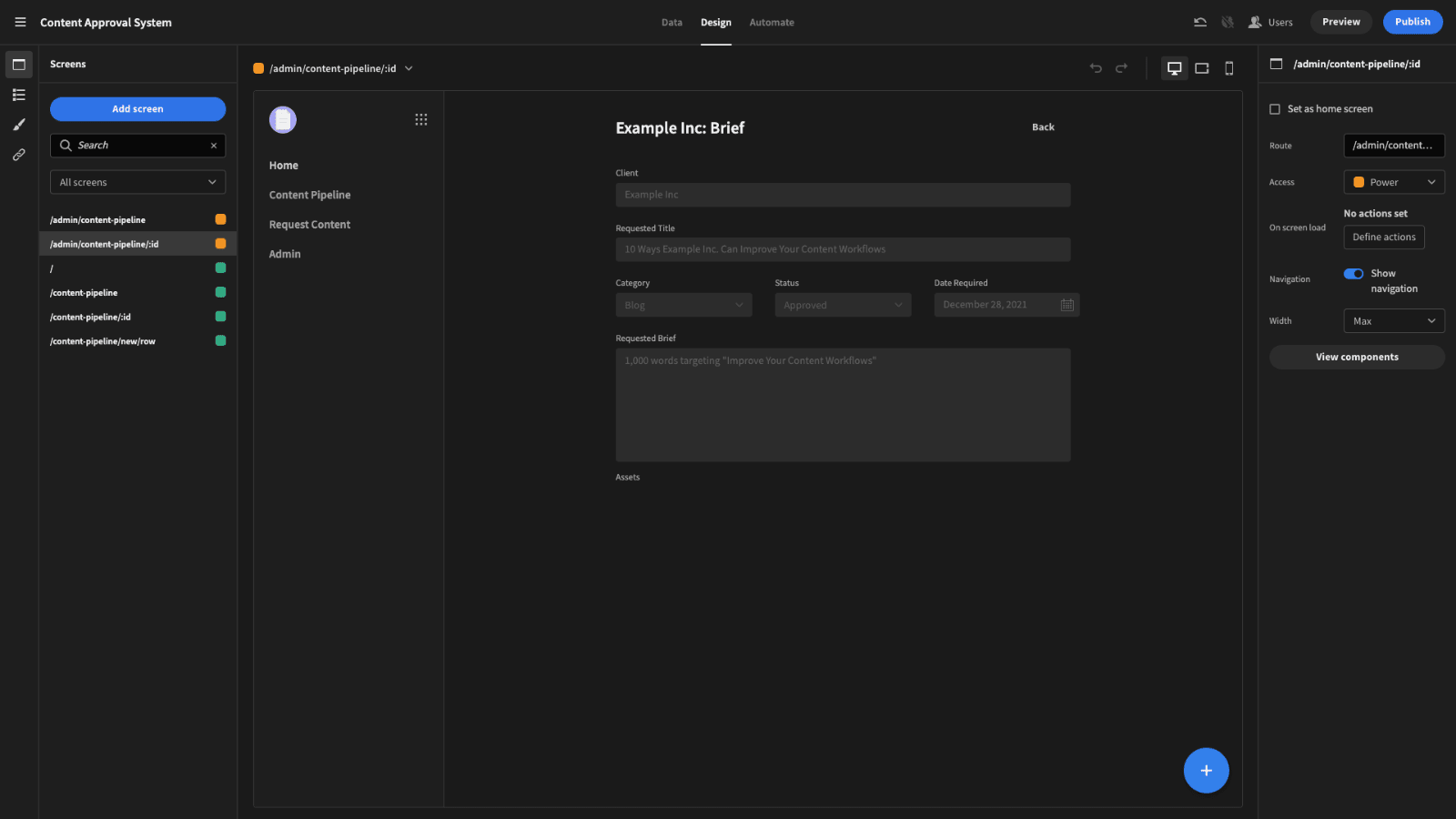What is Process Innovation?
Process innovation is all about coming up with new, better ways to carry out everyday internal tasks. Nowadays, this primarily means innovating with new technologies - although this is by no means the only option.
Indeed, we’ll see today that we have levers to pull across our wider operations, company culture, governance, training, HR, finance, and more. But of course, technology will still almost inevitably play a role within each of these verticals.
Today, we’re diving into everything you need to know.
We’ll start with the core theory around how this fits into your wider ops and some of the most common applications for process innovation. Then, we’ll move on to thinking about how we can put what we’ll learn into practice across your organization.
We’ll wrap up by thinking about some of the tools you can use to empower your team to come up with new, better ways to carry out critical work within their departments - including how Budibase is transforming the landscape here.
First, though, let’s get a grip on the basics.
What is process innovation?
Process innovation means designing and implementing new solutions to substantially improve your internal processes. The operative word here is substantially. See, we can distinguish this from process optimization, which involves more incremental change.
It’s a little bit tricky to draw a clean line here though. So, what does this distinction look like in practice?
An incremental change would be something like removing redundant steps or decisions. A substantial change would address more fundamental aspects of how your team carries out relevant tasks.
The most prominent example of this is digitalization.
For instance, implementing new internal tools to replace spreadsheets or even pen and paper within internal processes.
We can also distinguish process innovation from other kinds of operational improvements in terms of who is involved in defining changes. This varies from company to company, but one important characteristic of process innovation is the potential to be more democratic.
So, rather than changes being exclusively top-down, process innovation often provides a framework for empowering your team to come up with new ways of working that reflect their real-life pain points.
Of course, this is a lot easier said than done.
As we’ll see a little later, we’re constrained by the time, tools, resources, and skills that our team can draw on to innovate. We’ll also need to be smart about how we govern process innovation - since we can’t just allow anyone to do whatever they want.
Take a look at our tutorial on workflow management database design .
Before we get to that though, let’s think more deeply about why you’d bother with any of this in the first place.
Why does process innovation matter?
In other words - what do you stand to gain from process innovation? The unfortunate truth is that it’s never been more difficult for businesses to maintain a competitive edge.
With rising costs, high rates of technological change, and increasingly stiff competition, it’s critical that we constantly seek out new ways to retain profitability.
We can apply this logic to all levels of our business - from simple admin tasks to new product development.

(BP Trends)
Ultimately, the goal with process innovation is to seek out new ways to do more with less - either finding ways to boost productivity or to enhance efficiency. In both cases, the end result is maximizing profitability.
We can go after non-monetary benefits too. At least, not explicitly monetary ones.
One major aspect of this is the fact that we’re effectively empowering our teams to take more ownership over their own daily work. This can pay huge dividends in terms of morale, motivation, and even employee retention.
Besides this, there are process-specific benefits to consider.
Obviously these are a bit harder to generalize about but, broadly speaking, the idea is that we improve our ability to achieve the goal of whatever process we’re dealing with. Say - for example - improving accuracy within a data entry workflow.
It’s also worth recognizing that any of these secondary benefits can have a knock-on impact on our finances. So, we’d save money on hiring costs by improving employee retention, for example.
It’s important to keep each of these in mind as they’ll help us to set informed goals around our process innovation initiatives. Take a look at our guide to creating a process improvement plan .
Who is responsible for innovation?
Earlier, we hinted at the idea that process innovation can be a more democratic kind of operational change.
It’s important to drill a bit further into this - since it has the potential to lead to confusion.
The key issue here is responsibility. We can examine this at a few different levels.
The most obvious is who we empower to innovate. As we said earlier, it’s unlikely that we’ll want to give every employee carte-blanche to carry out tasks however they want.
Therefore, there’s inevitably a balance to be struck. Part of the reason for this is that the more colleagues we allow to innovate, the more we’ll need to put measures in place to govern this. We’ll come back to the practicalities of this in a second.
On the flip side, the more we restrict process innovation to a select few employees, the more we limit ourselves in terms of the potential benefits that we saw a second ago.
As such, there’s no one-size-fits-all framework here.
One way of getting around this is to focus on how we divide up responsibilities amongst different internal roles. For instance, empowering on-the-ground colleagues to experiment or ideate on innovative ideas, but centralizing responsibility for rolling them out.
This isn’t the only approach available to us though.
Another option is to designate specific employees with a mandate for process innovation within individual departments. Say - an existing line manager, or some other reasonably technical colleague that we upskill in low-code development.
This is not to say that process innovation has to be driven from the bottom up. Rather, it would be just as valid to control this from the ops or IT department - perhaps with increased input from on-the-ground colleagues.
But, one benefit of a ground-up approach is to limit the extra burden on your IT team.

(McKinsey )
Process innovation governance
Whoever you decide is going to drive your process innovation efforts, you’ll also need to plan around how to control their output. So - our best-case scenario is that an employee comes up with a revolutionary way of doing something, that’s going to save us heaps of money.
We still couldn’t just simply let them take a solo run on implementing their changes. This would quickly lead to chaos. Think, when is something process innovation and when is it simply acting outside the rules?
Instead, we need clear governance instruments in place to ensure our team doesn’t undermine other important concerns in pursuit of efficiency savings.
Defining the scope of process innovation
We used the word mandate a little earlier - and this is an important concept. Basically, this sets out the scope of what different colleagues can do within the bounds of process innovation.
One way to approach this is to focus on the kinds of processes that are within colleagues’ mandate to try and improve.
For example, you might be happy for your service team to try and come up with new ways to triage customer problems. You’re not likely to allow them to alter more sensitive processes or mission-critical ones, like order fulfillment.
You’ll need to figure out where the line is for your particular business.
We’ll also need to define what kinds of innovation are permissible and what procedures colleagues need to follow to put their ideas into practice. There are some process elements where we can’t allow on-the-ground colleagues to go off-piste.
For instance, we can’t allow them to alter internal roles and responsibilities. By extension, we can’t include anything outside of an employee’s own existing permissions within their innovation mandate.
Approving innovations
In terms of roll-out procedures, the key challenge is how we test, validate, approve, and implement ideas. At the most basic level, we need to define who is responsible for deciding who is responsible for deciding which ideas go ahead.
We also need to define the rules that govern this.
Effectively, we need to determine whether or not there’s a business case for whatever the proposed change is. So, you can think about what evidence employees should provide around the need for change, as well as the suitability of their proposed solution.
On the one hand, this means testing and verifying that it actually succeeds on its own terms - that is, it does what the employee responsible says it will.
On the other, we also need to consider the wider impact of any proposed changes.
There are a couple of things to keep abreast of here.
First, there’s the issue of process dependencies. We need to have confidence that changing one process won’t break others. Second, there’s the fact that changes can have unintended consequences.
This is a particular problem with bottom-up process transformation. See, on-the-ground users have their own priorities - typically related to making their lives easier. This is a great way to find efficiencies, but they might fail to account for other issues.
For example, we can’t expect every employee to be a security or compliance expert. This is potentially a big problem if we want to allow colleagues to ship their own tools without creating unnecessary risks,
While we can address this to some extent with our choice of process innovation tools and governance instruments, we still need someone with appropriate competencies to have the final say.

(McKinsey )
How to create a process innovation policy
Now, we can start to tie everything we’ve learned together by thinking about how we can design a process innovation policy of our own.
Remember, the likelihood is that your existing processes, your goals, and the resources you have available will be very different from even direct competitors. As such, it’s vital that we have a policy that matches our unique situation.
Check out our guide on how to streamline business processes .
Here are the steps you can follow to craft a process innovation policy.
1. Define your goals
First of all, we need clarity around why we’re implementing a process transformation initiative. As in - what is it that we want to achieve? We saw the specific metrics we could go after earlier, but it’s worth noting that we can actually think about this at two distinct levels.
An easy way to think about this is to separate:
- What we want to achieve with our process transformation initiatives as a whole.
- What we want colleagues to achieve through individual process transformation efforts.
As you might expect, these are highly interrelated. For the most part, the first largely informs the second.
Say our top-level goal was to find efficiency savings to cut administrative costs by 10%.
We’d obviously want the more granular goals that we set for our colleagues to reflect this. So, we might want them to focus on cutting labor hours, error rates, redundancy, or other process elements that breed inefficiencies.
2. Select colleagues
Next, we can outline which colleagues we’re going to mandate for process transformation. We already laid out the pros and cons of different approaches here, so there’s no sense in repeating ourselves.
So how do we make our decision?
We might start by considering which departments we want to involve. For instance, you might want sales and marketing colleagues to take more ownership over internal processes, but not their counterparts in logistics or customer service.
We also need to be cognizant of the size of our teams. In small teams with only a handful of colleagues, we can often afford to afford more people the ability to provide input into processes.
When teams get larger, we’ll need more centralization. This doesn’t negate the possibility of process innovation, but it might lead us to reserving our initiative for more senior or technical colleagues.
3. Provide a clear mandate
Once we know who is going to be involved in process innovation, we next need to clearly define their mandate. That is - what processes they can work on and the kinds of changes they can make.
Obviously, this is an area where it can be tough to generalize.
One approach is to focus on outlining the processes that are off-limits within your innovation initiative. For example, if we want to retain centralization over anything involving customer data or payment processing.
In terms of the kinds of transformations we want colleagues to work on, we need to strike a balance between facilitating innovation and ensuring that our team works on productive avenues - things that are actually going to be viable solutions.
Effective guidance and upskilling are vital here.
In other words, our team must have a strong working understanding of the factors that influence whichever metrics we decide to set our goals around.
4. Provide the right tools
This is one we have only touched on briefly so far. As we’ve seen already, digitalization has a huge role to play in process transformation. In fact, it’s difficult to imagine many processes reaching their optimal form without some degree of digital transformation.
There are a few big categories of solutions that come into play here. Providing the right tools means enabling your colleagues to build the solutions they need, using platforms that are appropriate for their technical skill levels.
What kinds of solutions are your team likely to ship as part of process transformation efforts?
First, we have internal tools and dedicated UIs for carrying out specific kinds of tasks more effectively. For instance, form UIs for carrying out common data management actions with greater speed and accuracy.
Secondly, automation obviously plays a critical role in streamlining processes.
This is also one of the most fruitful areas for on-the-ground employees to add value - although you might not expect this to be the case. See, nowadays, there is a range of options on the market for user-defined automations.
This includes RPA, automation features within a growing number of SaaS platforms, low-code development tools, and increasingly accessible AI and machine learning platforms.

(McKinsey )
We’ll see where Budibase fits into this spectrum a little bit later.
Finally, we have integration platforms, like Zapier and Make. This is a solution class that specifically aims to enable non-technical users to connect otherwise separate tools in order to pass data back and forth, or even create integrated automations.
Check out our ultimate guide to internal processes to learn more.
5. Create approval processes
Once we’ve established what our colleagues can build and how, we also need to define processes for getting solutions approved and shipped. Again, we’ve seen most of the theory here already.
What remains is simply laying out a framework for putting this into practice.
Just like before, our first step is deciding who is ultimately responsible for which ideas go ahead. For example, do we retain this responsibility with the IT or ops teams or do we delegate it to individual departmental leaders?
Or, in smaller teams with limited innovation mandates, we might opt for less restrictive processes - especially if proposed changes are only likely to affect the employee in question’s own tasks or productivity.
With this established, we need to set out the business rules for deciding if individual proposed changes should be rolled out.
One way of thinking about this is comparing the purpose of our existing process to the expected outcomes of the new one. So, are we really achieving the same thing in a better way?
For technical changes - including new solutions or applications - we’ll also need to carry out the same quality assurance checks and testing as we would with any other kind of internally-built software.
We obviously can’t ship any new tools without validating that they actually work as expected first.
6. Measure and monitor outcomes
Finally, we must have a framework in place for assessing the effectiveness of our process innovation initiative - both at the level of individual changes and more broadly.
For this, we’ll need to return to the goals we established earlier.
For example, are we actually succeeding in creating efficiency savings? Are we doing so to the extent that we hoped?
Importantly though, this isn’t a yes or no exercise. Rather, in either case, we should constantly be on the lookout for additional improvements. Realistically, there’s almost invariably going to be scope for more optimization.
Besides this, we want to seek out opportunities to carry forward learnings from our process transformation efforts.
One critical element of this is documentation. So, in addition to stipulating how users can create different kinds of solutions, we should also seek to control what information they provide about them.
This is invaluable whether the transformation was successful or not. If something worked, documentation is a helpful resource to try and replicate the results across other, similar processes.
If something didn’t end up being a viable solution, then documenting this helps our team to avoid wasting time on the same initiative in the future.

Manage internal processes with Budibase
Low-code development is an essential part of modern process innovation efforts. The right solutions here are the key to empowering your team to create innovative solutions for all manner of business problems.
Let’s take a look at why Budibase leads the pack.
Our open-source, low-code platform
Budibase is the fast, efficient way for busy teams to create professional web applications. Our design philosophy is simplicity by default; extensibility when you need it.
Check out our features overview to see how we empower teams to turn data into action.
Extensive data connectivity
No other low-code platform comes close for external database support. We offer dedicated connectors for SQL, Postgres, Google Sheets, REST, Mongo, Couch, Airtable, Dynamo, Oracle, S3, Arango, and more.
We’ve even got our own built-in database, with full support for CSV uploads. It’s never been easier to centralize your business data.
Optional self-hosting
Budibase offers optional self-hosting. Deploy to your own infrastructure using Kubernetes, Docker, Docker Compose, Digital Ocean, Linode, Portainer, and more.
We also offer Budibase Cloud to get you up and running in seconds. Check out our pricing page to learn more about both options.
Intuitive automation tools
Create fully custom automation rules with minimal custom code. Budibase features a range of nestable, configurable automation actions and triggers, which you can use within our dedicated flow-based UI.
We also offer extensive integrability through webhooks, REST, and Zapier, so you can create more sophisticated rules using third-party app actions and events.
Configurable RBAC
Budibase offers intuitive yet flexible role-based access control across all of your applications. Assign users to one of our pre-defined roles and grant permissions at the level of data sources, queries, automations, screens, or even individual components.
It’s never been easier to achieve the perfect levels of data exposure without sacrificing usability.
Custom plug-ins
We lead the pack for extensibility. Use our CLI tools to build your own data sources and components to ship across your Budibase tools.
Check out our plug-ins page to learn more.
50+ free application templates
Teams all over the world use Budibase to build solutions for all sorts of business problems. We’re so confident in what our platform can do that we’ve built more than 50 free, totally customizable app templates to help get you started.
Sign up to Budibase today to start building web apps the smart way, for free.